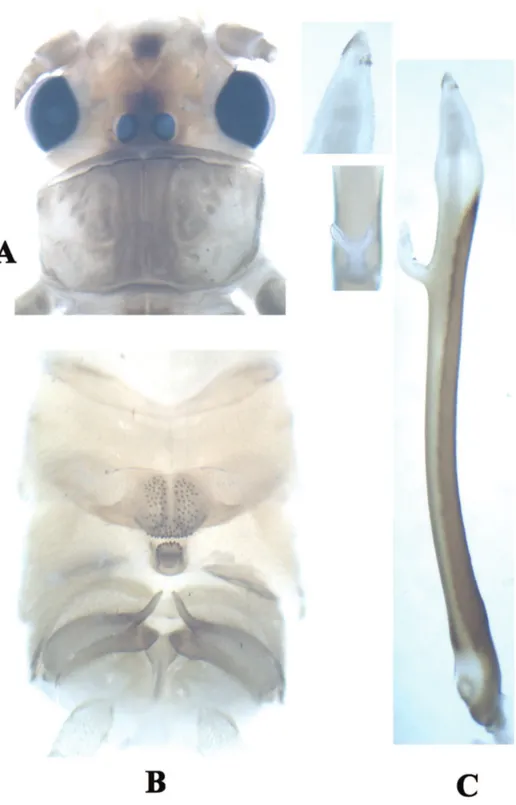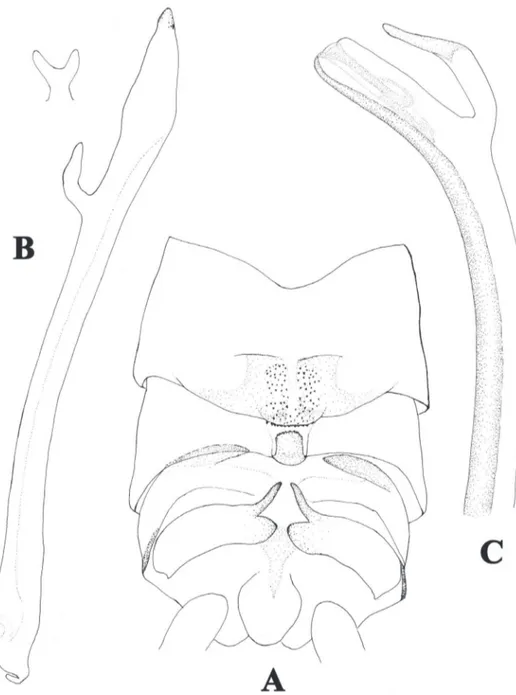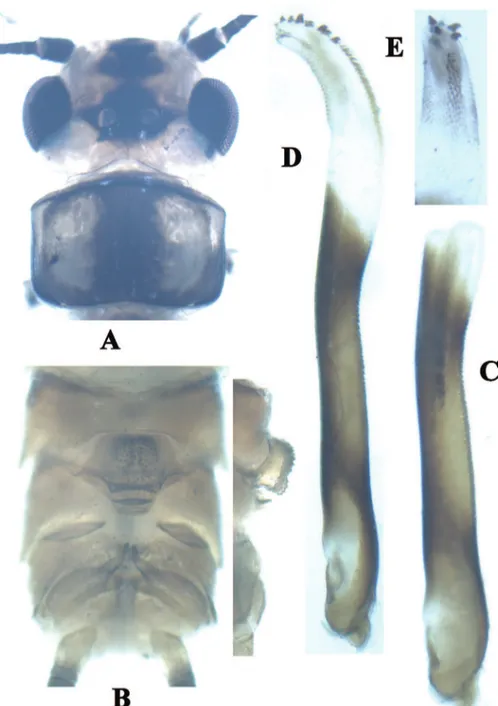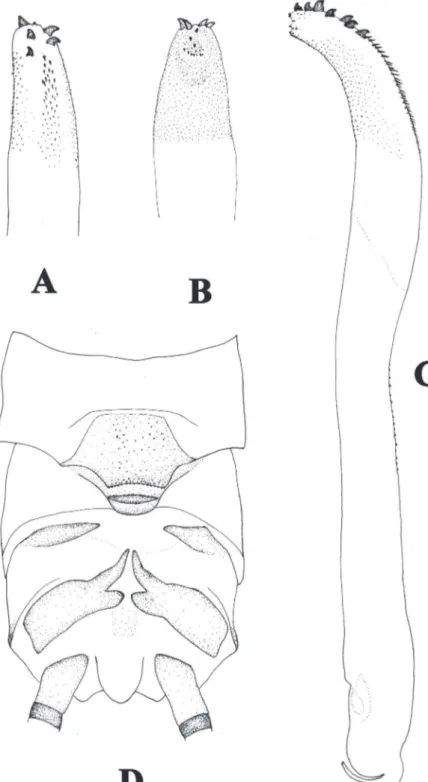Two new species of Neoperla
(Plecoptera, Perlidae) from China
Li Wei-Hai1,†, Wang Guo-Quan2,‡, Qin Xue-Feng1,§
1 Department of Plant Protection, Henan Institute of Science and Technology, Xinxiang, Henan 453003, China 2 Department of Plant Protection, Guangxi University, Nanning, Guangxi 530004, China
† urn:lsid:zoobank.org:author:81D57DE5-E00B-4F6B-A0B3-E81D3C865208 ‡ urn:lsid:zoobank.org:author:351B5BB1-A386-43D3-AE8D-4A273CA7BA4D § urn:lsid:zoobank.org:author:BE842E0F-F8DE-4BCF-9490-98AC6157E84A
Corresponding author:Li Wei-Hai (lwh7969@163.com)
Academic editor:C. Geraci | Received 24 December 2012 | Accepted 28 March 2013 | Published 16 April 2013
urn:lsid:zoobank.org:pub:1DE1E464-DA28-4A76-A1D2-D1B0E7D13AD2
Citation: Li W-H, Wang G-Q, Qin X-F (2013) Two new species of Neoperla (Plecoptera, Perlidae) from China. ZooKeys 290: 21–30. doi: 10.3897/zookeys.290.4568
Abstract
Two species of the genus Neoperla from China are described as new: Neoperla furcostyla sp. n., and N. similidella sp. n. The new species are compared to similar taxa.
Keywords
Plecoptera, Perlidae, Neoperla, new species, China
Introduction
he stonely genus Neoperla belongs to the family Perlidae and it is the most speciose
genus within the subfamily Perlinae (DeWalt et al. 2012). It is distinguished from
other genera of the subfamily by two close located ocelli, and by the abdominal ter-gum 7 with lobe-like processes and aedeagal tube variously armed with spines or spiny lobes (Sivec et al. 1988). here are up to 68 known species in China described by Chu (1929), Du (1999, 2000a, b), Du and Sivec (2004, 2005), Du and Wang (2005, 2007), Du et al. (1999), Du et al. (2001), Sivec and Zwick (1987), Wu (1935, 1938,
www.zookeys.org
Copyright Li Wei-Hai et al. This is an open access article distributed under the terms of the Creative Commons Attribution License 3.0 (CC-BY), which permits unrestricted use, distribution, and reproduction in any medium, provided the original author and source are credited.
Wang (2011), Li et al. (2012) and Li et al. (2012).
In the present paper, we describe two additional species as new to science:Neoperla furcostyla sp. n., and N. similidella sp. n. from Guangxi autonomous region and Fujian Province, respectively. All types, including paratypes, are deposited in the Entomologi-cal Museum of China Agricultural University (CAU). Aedeagi were everted using the cold maceration technique of Zwick (1983).
Taxonomy
Neoperla furcostyla Li & Qin, sp. n.
urn:lsid:zoobank.org:act:757404FC-9474-4C97-AAF2-36DB91DB9525 http://species-id.net/wiki/Neoperla_furcostyla
Figs 1–2
Type material.Holotype: male, China: Guangxi autonomous region, Nanning City, Wuming County, Mt. Damingshan, 23.4047N, 108.4772E, 9 Aug. 2011, Zhang Ting–Ting. Paratypes: 5 males, same data as holotype.
Description. Male. Forewing length 16.6–16.9 mm. General body color brown-ish. Distance between ocelli about as wide as diameter of ocellus. Head slightly wid-er than pronotum, latwid-eral margins and M-line pale, a large medial portion brown with area between ocelli and a triangular patch on frons darker (Fig. 1A); compound eyes dark; antennae brown. Pronotum pale brown with medial portion brown (Fig. 1A); wing membrane subhyaline, veins brown; legs evenly brown. Abdomen brown, hemiterga darker.
Terminalia. Tergum 7 process forming a sclerotized, upraised plateau, covered with many small sensilla basiconica (Figs 1B, 2A). Tergum 8 with a recurved quad-rate process bearing small spines at distal margin. Tergum 9 without sensilla patches. Hemitergal processes of tergum 10 short and slightly curved (Figs 1B, 2A). Aedeagal tube very long and almost straight, but bearing a pale bifurcate structure with com-mon stem located subapically (Figs 1C, 2B); dorsal surface heavily sclerotized and membraneous areas on ventral surface gradually enlarged toward tip of the tube. Ae-deagal sac very short, about one ifth as long as tube, triangular in shape; with gran-ules around sac apex and several dorsoapical spines and patch of smaller ventroapical spines (Fig. 2B).
Female. Unknown.
Etymology. he speciic epithet refers to the subapical forkof the aedeagal tube.
Distribution. China (Guangxi).
Figure 2. A–C Neoperla furcostyla Li and Qin, sp. n. (male). A Terminalia, dorsal view B Aedeagus, lateral view C Aedeagus of Neoperla forcipata Yang and Yang, lateral view.
smaller ventroapical spines are present at apex (Figs 1C, 2B). he type of the aedeagus
of the new species is also found in N. forcipata Yang & Yang, 1992 known from Mt.
near the subapical fork, and the fork is much larger than that of N. furcostyla. he sac of N. forcipata though not everted, has an evident lateral lap subapically that is absent on the sac found in N. furcostyla. he new species is assigned to the Diehli subgroup of the Montivaga species group (Zwick 1983).
Notes. he holotype of N. forcipata Yang and Yang is apparently damaged at the
base of the aedeagal tube, very possibly due to an overlooking of this elongate type of tube during the course of dissection. In this case, it is safe to cut the abdominal at the ifth or preceding segments in order to keep this kind of tube intact after dissection.
Neoperla similidella Li & Wang,sp. n.
urn:lsid:zoobank.org:act:2549F9C7-9FEF-4BF6-B044-783CA798F6F5 http://species-id.net/wiki/Neoperla_similidella
Figs 3–4
Type material.Holotype: male, China: Fujian Province, Mt. Wuyishan, Kekao Sta-tion, 735 m, 27.7478N, 117.6831E, light trap, 12 Jul. 2009, Shi Li and Liu Xiao-Yan. Paratypes: 2 males, same data as holotype.
Description. Male. Forewing length 12.6–12.8. General body color dark brown. Distance between ocelli ca. 1.5X as wide as diameter of ocellus. Head slightly wider than pronotum, with a large black ocellar patch barely touching the compound eyes and a black trapezoidal patch on frons (Fig. 3A); compound eyes dark; antennae dark brown. Pronotum dark brown with pale brown to brown lateral margins (Fig. 3A); wing membrane pale brown, veins dark; legs yellow, basal third of tibiae darker.
Abdo-men dark brown, terminalia darker. Cerci dark except 1st segment brown.
Terminalia. Process of tergum 7 large, rounded and upraised, mostly covered with sparse sensilla basiconica but margined with denser sensilla basiconica patches (Fig. 3B). Tergum 8 with an upcurved tongue-shaped process, fringed with small distal spines. Tergum 9 without sensilla patches. Hemitergal processes of tergum 10 slightly curved medially (Figs 3B, 4D). Aedeagal tube darkly sclerotized, slender and mostly straight but with a gradual dorsoapical curve, dorsal surface heavily sclerotized, with many spinules on dorsal surface (Fig. 3C). Aedeagal sac about half as long as tube and gradually curved ventrad; along dorsoapical surface with a patch of small and median sized spines, and two rows of large stout spines apically (ca. 7 spines) (Figs 3E, 4A); mostly ventral and lateral surfaces of apical half of sac with small spines (Figs 3D, 4C); apex of the sac with several medium sized spines (Figs 4B).
Female. Unknown.
Etymology. he speciic epithet refers to the great similarity to the species N. idella Stark and Sivec, 2008.
Distribution. China (Fujian Province).
Figure 3. Neoperla similidella Li and Wang, sp. n. (male). A Head and pronotum, dorsal view B Terminalia, dorsal view C Aedeagus before eversion, lateral view D Aedeagus, lateral view e Aedeagal sac, dorsal view.
(Stark and Sivec 2008, Figs 36–37). In addition, the aedeagal sac of N. idella lacks a ventroapical patch of small spines and also lacks medium sized spines. Both species bear similar patches of large spines on the dorsoapical margin of the sac but in the new species the ventrolateral patch of small and medium spines is located nearer the sac apex than in N. idella.
Acknowledgments
We acknowledge the partial support of our research by the National Natural Science Foundation of China (No. 31000977).
References
Chu Y-T (1929) Descriptions of four new species and one new genus of stone-lies in the family Perlidae from Hangchow. he China Journal 10: 88–92.
DeWalt RE, Neu-Becker U, Stueber G (2012) Plecoptera Species File Online. Version 1.0/4.1. [12/16/2012] http://Plecoptera.SpeciesFile.org
Du Y-Z (1999) Plecoptera. In: Huang BK (Ed.) Fauna of Insects in Fujian Province of China. Vol. 3. Fujian Science and Technology Publishing house, Fuzhou, Fujian, 301–335. Du Y-Z (2000a) Neoperla magisterchoui, a new species of the genus Neoperla Needham
(Plecop-tera: Perlidae) from China. In: Zhang YL (Ed.) Systematic and faunistic research on Chi-nese insects. Proceedings of the 5th National Congress of Insect Taxonomy. China Agri-culture Press, Beijing, 1–3.
Du Y-Z (2000b) Two new species of the genus Neoperla Needham (Plecoptera: Perlidae: Per-linae) from Guizhou, China. Entomotaxonomia 22: 1–5.
Du Y-Z, Sivec I (2004) Plecoptera: Perlidae, Nemouridae, Leuctridae. In: Yang XK (Ed.), Insects from Mt. Shiwandashan area of Guangxi. China forestry Publishing House, Beijing, 39–45.
Du Y-Z, Sivec I (2005) Plecoptera.In: Yang XK (Ed.) Insect Fauna of Middle-west Qinling Range and South Mountains of Gansu Province. Science Press, Beijing, 38–54.
Du Y-Z, Wang Z-J (2005) Plecoptera: Leuctridae, Nemouridae, Perlidae and Peltoperlidae. In: Yang MF, Jin DC (Eds) Insects from Dashahe Nature Reserve of Guizhou. Guizhou People Press, Guiyang, Guizhou, 51–57.
Du YZ, Sivec I, He J-H (1999) A checklist of the Chinese species of the family Perlidae (Plecop-tera: Perloidea). Acta Entomologica Slovenica 7: 59–67.
Du Y-Z, Sivec I, Zhao M-S (2001) Plecoptera. In: Wu H, Pan CW (Eds) Insects of Tian-mushan National Nature Reserve. Science Press, Beijing, 69–80.
Li W-H, Wang R-F (2011) A new species of Neoperla (Plecoptera: Perlidae) from China. En-tomological News 122: 261–264.
Li W-H, Wang H-L, Lu W-Y (2011) Species of the genus Neoperla (Plecoptera: Perlidae) from Henan, China. Zootaxa 2735: 57–63. doi: 10.3157/021.122.0308
Li W-H, Wang G-Q, Lu W-Y (2012) Species of Neoperla (Plecoptera: Perlidae) from Hubei, China.Zootaxa3478: 32–37.
Li W-H, Wang G-Q, Li W-L, Murányi D (2012) Review of Neoperla (Plecoptera: Perlidae) from Guangdong Province of China. Zootaxa 3597: 15–24.
Li W-H, Wu L-M, Zhang H-R (2011) A new species of the genus Neoperla (Plecoptera: Perli-dae) from Henan, China. Acta Zootaxonomica Sinica 36: 33–35.
Sivec I, Zwick P (1987) Some Neoperla (Plecoptera) from Taiwan. Beiträge zur Entomologie 37: 391–405.
Sivec I, Stark BP, Uchida S (1988) Synopsis of the world genera of Perlinae (Plecoptera: Perli-dae). Scopolia 16: 1–66.
Stark BP, Sivec I (2008) New species and records of Neoperla (Plecoptera: Perlidae) from Vi-etnam. Illiesia 4: 19–54.
Wu C-F (1935) Aquatic insects of China. Article XXI. New species of stonelies from East and South China. (Order Plecoptera). Peking Natural History Bulletin 9: 227–243.
Wu C-F (1938) Plecopterorum sinensium: A monograph of stonelies of China (Order Plecop-tera). Yenching University, 225 pp.
Wu C-F (1948) Fourth supplement to the stonelies of China (Order Plecoptera). Peking Natural History Bulletin 17: 75–82.
Wu C-F (1962) Results of the Zoologico-Botanical expedition to Southwest China, 1955– 1957 (Plecoptera). Acta Entomologica Sinica 11 (Supplement): 139–153.
Wu C-F (1973) New species of Chinese stonelies (Order Plecoptera). Acta Entomologica Sinica 16: 97–118.
Wu C-F, Claassen PW (1934) Aquatic insects of China. Article XXI. New species of Chinese stonelies. (Order Plecoptera). Peking Natural History Bulletin 9: 111–129.
Yang C-K, Yang D (1990) New and little-known species of Plecoptera from Guizhou Province (I). Guizhou Science 8: 1–4.
Yang C-K, Yang D (1991) New and little-known species of Plecoptera from Guizhou Province (II). GuizhouScience 9: 48–50.
Yang D, Yang C-K (1992) Plecoptera: Perlidae. In: Huang FS (Ed.) Insects of Wuling Moun-tains area, Southwestern China. Science Press, Beijing, 62–64.
Yang D, Yang C-K (1993) New and little‐known species of Plecoptera from Guizhou Province (III). Entomotaxonomia 15: 235–238.
Yang D, Yang C-K (1995a) hree new species of Plecoptera from Hainan Province. Acta Agri-culture Universitatis Pekinensis 21: 223–225.
Yang D, Yang C-K (1998)Plecoptera: Styloperlidae, Perlidae and Leuctridae.In: Wu H (Ed) Insects of Longwangshan. China Forestry Publishing House, Beijing, 40–46.



